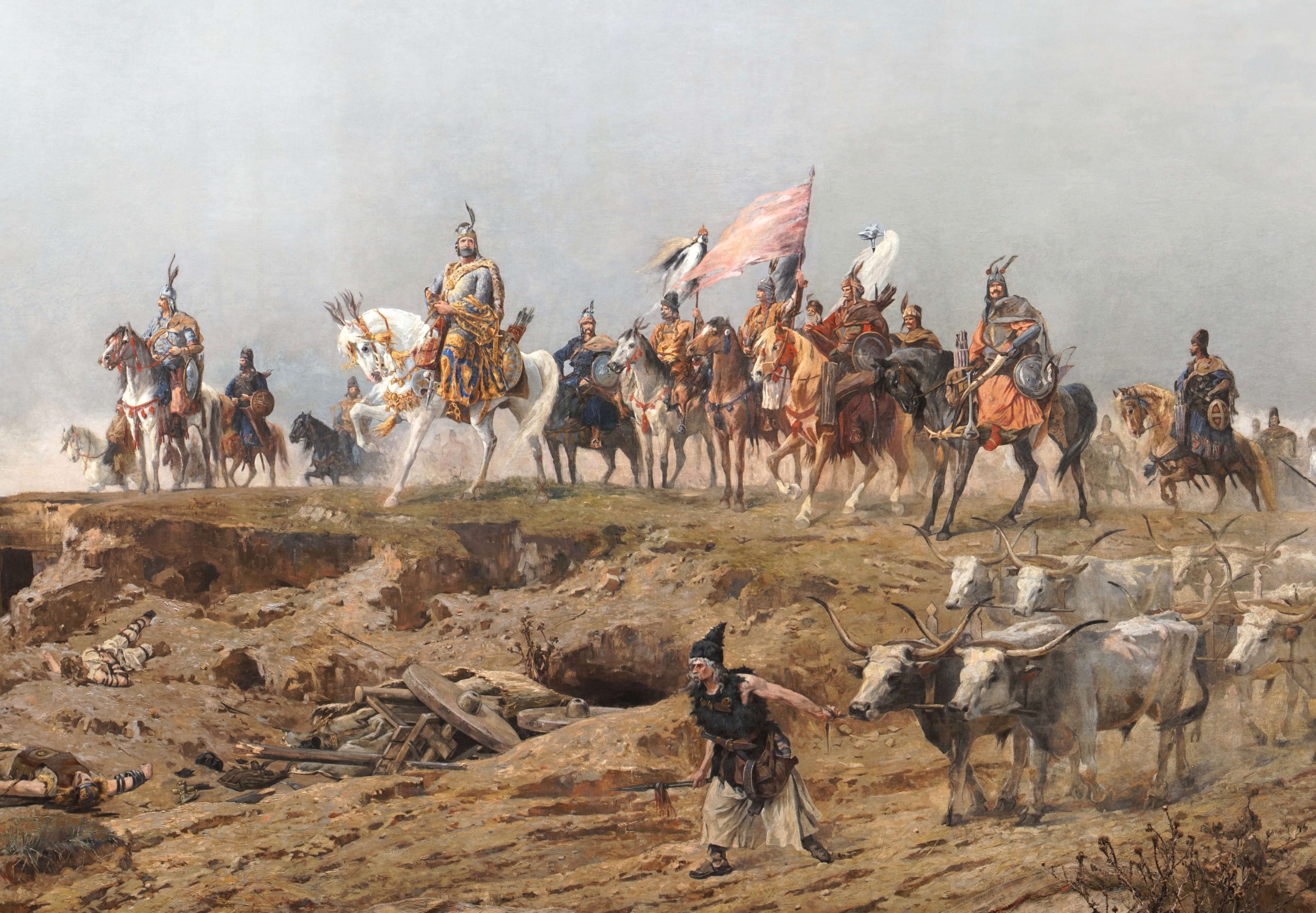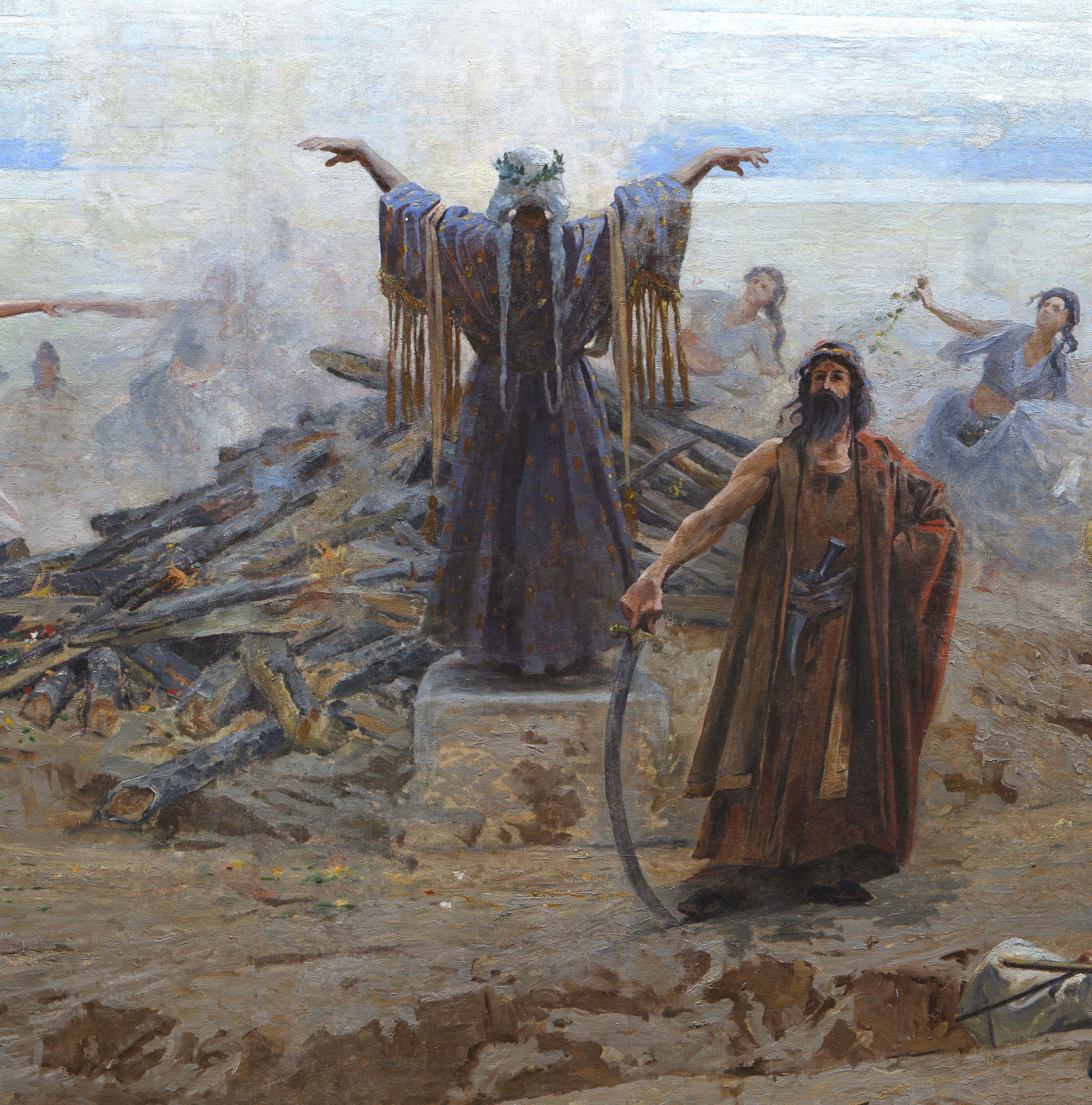Arrival Of The Hungarians on:
[Wikipedia]
[Google]
[Amazon]
The ''Arrival of the Hungarians '' ( hu, A magyarok bejövetele; commonly known as ''Feszty Panorama'' or ''Feszty Cyclorama'', hu, Feszty-körkép) is a large




 In 1891, Árpád Feszty saw a panoramic painting by Detaille and Neuville in
In 1891, Árpád Feszty saw a panoramic painting by Detaille and Neuville in  The day of the opening was May 13, 1894. Huge crowds wanted to see the painting, the biggest attraction of the millennial exhibition in Hungary, commemorating the 1000th anniversary of the conquest. Today, most historians accept 895 as the year of the conquest; however, the millennial celebrations were held in 1896.
The canvas was later transported to London for the 1899
The day of the opening was May 13, 1894. Huge crowds wanted to see the painting, the biggest attraction of the millennial exhibition in Hungary, commemorating the 1000th anniversary of the conquest. Today, most historians accept 895 as the year of the conquest; however, the millennial celebrations were held in 1896.
The canvas was later transported to London for the 1899

 In the 1970s, a decision was made to build a National Heritage Park in
In the 1970s, a decision was made to build a National Heritage Park in
Ópusztaszer National Memorial Site
Cycloramas Hungarian paintings 1894 paintings Horses in art
cyclorama
A cyclorama is a panoramic image on the inside of a cylindrical platform, designed to give viewers standing in the middle of the cylinder a 360° view, and also a building designed to show a panoramic image. The intended effect is to make vie ...
– a circular panoramic painting
Panoramic paintings are massive artworks that reveal a wide, all-encompassing view of a particular subject, often a landscape, military battle, or historical event. They became especially popular in the 19th century in Europe and the United St ...
– by Hungarian painter Árpád Feszty
Árpád Feszty (; 21 December 1856 – 1 June 1914) was a Hungarian people, Hungarian Painting, painter.
He was born in the town of Ógyalla (then Kingdom of Hungary (1526–1867), Hungary, now Hurbanovo, Slovakia). His ancestors were Ger ...
and his assistants, depicting the beginning of the Hungarian conquest of the Carpathian Basin
The Hungarian conquest of the Carpathian Basin, also known as the Hungarian conquest or the Hungarian land-taking (), was a series of historical events ending with the settlement of the Hungarians in Central Europe in the late 9th and early 10t ...
in 895.
It was completed in 1894 for the 1000th anniversary of the event. Since the 1100th anniversary of the event in 1995, the painting has been displayed in the Ópusztaszer National Heritage Park
The Ópusztaszer National Heritage Park is an open-air museum of Hungarian history in Ópusztaszer, Hungary. It was established in 1982 and is most famous for being the location of the Arrival of the Hungarians, Feszty Panorama, a cyclorama by ...
, Hungary
Hungary ( hu, Magyarország ) is a landlocked country in Central Europe. Spanning of the Carpathian Basin, it is bordered by Slovakia to the north, Ukraine to the northeast, Romania to the east and southeast, Serbia to the south, Croatia a ...
.
The cyclorama
The painting is nearly 15 meters (50 feet) tall and almost 120 meters (400 feet) in length.History




 In 1891, Árpád Feszty saw a panoramic painting by Detaille and Neuville in
In 1891, Árpád Feszty saw a panoramic painting by Detaille and Neuville in Paris
Paris () is the capital and most populous city of France, with an estimated population of 2,165,423 residents in 2019 in an area of more than 105 km² (41 sq mi), making it the 30th most densely populated city in the world in 2020. S ...
. At first, his idea was to paint the biblical flood
The Genesis flood narrative (chapters 6–9 of the Book of Genesis) is the Hebrew version of the universal flood myth. It tells of God's decision to return the universe to its pre- creation state of watery chaos and remake it through the microc ...
in a similar manner, but on advice of his father-in-law, the famous Hungarian writer Mór Jókai
Móric Jókay de Ásva (, known as ''Mór Jókai''; 18 February 1825 – 5 May 1904), outside Hungary also known as Maurus Jokai or Mauritius Jókai, was a Hungarian nobleman, novelist, dramatist and revolutionary. He was an active participant ...
, he changed his mind and painted the ''Arrival of the Hungarians'' instead.
In order to create an authentic representation of the landscape, Feszty visited the Verecke Pass of the Carpathians
The Carpathian Mountains or Carpathians () are a range of mountains forming an arc across Central Europe. Roughly long, it is the third-longest European mountain range after the Ural Mountains, Urals at and the Scandinavian Mountains at . The ...
near Munkács
Mukachevo ( uk, Мукачево, ; hu, Munkács; see name section) is a city in the valley of the Latorica river in Zakarpattia Oblast (province), in Western Ukraine. Serving as the administrative center of Mukachevo Raion (district), the city ...
, where the Hungarians entered the Basin in 895. The approximate location of the viewpoint of the cyclorama is .
The Hungarian press constantly reported on the progress of the work. They predicted that the painting would be completed by August 20, 1893 (August 20 is the national day of Hungary, commemorating the canonization of King Saint Stephen of Hungary on August 20, 1083). Seeing the public's interest, the council of Budapest paid the costs. In the contract they named a Budapest location for the painting. Feszty wasn't able to finish in time for the August 20 holiday; as of August, only a small color draft was ready (the final painting is enormous, at 15×120 meters). In April, with the aid of Ignác Újváry, he painted the sky. Landscape details were painted by László Mednyánszky
Baron László Mednyánszky or ''Ladislaus Josephus Balthasar Eustachius Mednyánszky'' ( sk, Ladislav Medňanský) (23 April 1852 – 17 April 1919), a Slovak- Hungarian painter-philosopher, is one of the most enigmatic figures in the history ...
, Újváry and Spányi. The people were painted by Pál Vágó
Pál Vágó (6 June 1853, Jászapáti - 15 October 1928, Budapest) was a Hungarian painter, known for his historical scenes and cycloramas.
Biography
His father was a minor government official who died when Pál was still a small child. He or ...
and Henrik Papp
Henrik is a male given name of Germanic origin, primarily used in Scandinavia, Estonia, Hungary and Slovenia. In Poland, the name is spelt Henryk but pronounced similarly. Equivalents in other languages are Henry (English), Heiki (Estonian), Heik ...
, and the camps by Celesztin Pállya. More painters joined the work, as it was too much for Feszty and his companions to finish without help. Several writer, actor and musician friends entertained the painters as they worked.
On the spring of 1894, Feszty did the finishing touches, bringing the painting into overall harmony. After the work had been done, Feszty blamed himself for not finishing it by the deadline, and he ultimately lost 10,000 florins
The Florentine florin was a gold coin struck from 1252 to 1533 with no significant change in its design or metal content standard during that time. It had 54 grains (3.499 grams, 0.113 troy ounce) of nominally pure or 'fine' gold with a purcha ...
after paying the bills.
 The day of the opening was May 13, 1894. Huge crowds wanted to see the painting, the biggest attraction of the millennial exhibition in Hungary, commemorating the 1000th anniversary of the conquest. Today, most historians accept 895 as the year of the conquest; however, the millennial celebrations were held in 1896.
The canvas was later transported to London for the 1899
The day of the opening was May 13, 1894. Huge crowds wanted to see the painting, the biggest attraction of the millennial exhibition in Hungary, commemorating the 1000th anniversary of the conquest. Today, most historians accept 895 as the year of the conquest; however, the millennial celebrations were held in 1896.
The canvas was later transported to London for the 1899 Greater Britain Exhibition
The Greater Britain Exhibition was a colonial exhibition held at Earls Court in 1899 and opened by Prince George, Duke of Cambridge. on 8 May 1899.
Exhibits
Exhibits included a mineral exhibition from Victoria colony, a 120m cyclorama of the '' ...
. It was brought back to Budapest in 1909. The second exhibition of the painting opened on May 30, 1909. After that, restorations had to be done.
In the siege of Budapest
The Siege of Budapest or Battle of Budapest was the 50-day-long encirclement by Soviet Union, Soviet and Kingdom of Romania, Romanian forces of the Hungarian capital (political), capital of Budapest, near the end of World War II. Part of the b ...
during World War II
World War II or the Second World War, often abbreviated as WWII or WW2, was a world war that lasted from 1939 to 1945. It involved the vast majority of the world's countries—including all of the great powers—forming two opposin ...
, the building and the canvas of the cyclorama suffered damages. Rain and snow fell on the painting. After the changes to Hungary's borders, the only savior of the painting, István Feszty, nephew of Árpád Feszty, found himself outside of the new borders of Hungary; and Masa Feszty daughter of Árpád Feszty had no opportunity to save it either.
Rebirth

 In the 1970s, a decision was made to build a National Heritage Park in
In the 1970s, a decision was made to build a National Heritage Park in Ópusztaszer
Ópusztaszer (till 1974 Sövényháza) is a village in Csongrád county, in the Southern Great Plain region of southern Hungary. It is most known as the location of the Ópusztaszer National Heritage Park.
Geography
It covers an area of and ha ...
. Restoration of the painting and the construction of a new rotunda for the cyclorama began. The construction stopped in 1979, and parts of the canvas were again stored rolled up. In 1991, a Polish
Polish may refer to:
* Anything from or related to Poland, a country in Europe
* Polish language
* Poles, people from Poland or of Polish descent
* Polish chicken
*Polish brothers (Mark Polish and Michael Polish, born 1970), American twin screenwr ...
group of restorers won the contract for a new restoration. Since 1995 it has been on display again, together with artificial terrain and hidden speakers playing realistic sound effects. A great success, it is the main attraction of the heritage park of Ópusztaszer.
Annotations
Bibliography
;Notes ;References * Szűcs Á. - Wójtowicz M.: A Feszty-körkép (Helikon Kiadó, 1996) * {{cite book , last=MagyarSzo, title = Magyar Szo – Bulletin of the hungarian Community of New Zealand, edition=2008, year=2008, url=http://hungarianconsulate.co.nz/mszo/mszo91.pdf - Total pages: 44External links
Ópusztaszer National Memorial Site
Cycloramas Hungarian paintings 1894 paintings Horses in art